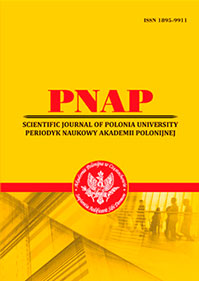MEANS OF VERBALIZING THE BASIC EMOTION OF “FEAR” IN THE AMERICAN TV SERIES “STRANGER THINGS“
Abstract
The emotion of fear is one of the fundamental psycho-emotional states inherent to human nature, which accompany humanity throughout its history.Researchers have persistently explored this phenomenon since the appearance of ancient philosophical theories. The relevance of studying fear in today’s media context underpins the necessity of the analysis of language means by which it is expressed, particularly in English-language television discourse.The purpose of this article is to identify the linguistic mechanisms of fear verbalization in the TV series “Stranger Things”, based on the speech of American teenagers and their families. The study employs a continuous sampling of linguistic material from the scripts of all four seasons of the series, amounting to a total duration of 33 hours. The methodology combines both quantitative and qualitative analysis of fear-related verbal markers within psycholinguistic and cognitive frameworks. The research focuses on phonetic and lexical features of fear expression, as well as stylistic means that intensify emotional impact. The findings demonstrate that fear is verbalized by means of raised tone, shouts, accelerated speech, and set phrases. Linguistic instruments include interjections, exclamations, direct forms of address, emotionally coloured vocabulary, obscenities, references to religious symbols, and repeated negations. Stylistic devices encompass comparisons, metaphors, hyperboles, and euphemisms, all of which contribute to a elevated emotional background and immerse the audience in a tense atmosphere. The analysis confirms that language functions as a powerful tool of conveying fear within the series.Characters convey fear through highly emotive language, where changes in speech pace, frequent outbursts, and imperative forms reflect strategies of either confronting or avoiding perceived threats. Thus, the linguistic representation of fear in “Stranger Things” has shown to be an interdisciplinary phenomenon, integrating both social and affective dimensions. The study concludes that the verbalization of fear in the series is implemented in a complex interplay of phonetic, lexical, and stylistic means, all of which serve as integral components of the overall narrative and emotional effect on the viewer. Future research could explore fear expression in the context of intercultural communication, as well as conduct comparative analyses of emotional representation in both fictional and cinematic discourse.
References
2. Ботвин Т.М. Вербалізація емоції страху в українських перекладах Біблії. Закарпатські філологічні студії. 2021. Вип. 18. С. 25–30.
3. Гнезділова Я.В. Емоційність та емотивність сучасного англомовного дискурсу: структурний, семантичний і прагматичний аспекти : автореф. дис. ... канд. філол. наук : 10.02.04. Київ, 2007. 20 с.
4. Кларк Д., Бек А.Т. Тривога і занепокоєння: когнітивно-поведінковий підхід. Київ : Діалектика, 2020. 448 с.
5. Овчаренко І.Б., Калініченко В.І. Загальна характеристика емоційної лексики в американському варіанті сучасної англійської мови. 2019. URL: https://jvestnik-sss.donnu.edu.ua/article/view/6681/6713 (дата звернення: 24.04.2025).
6. Підгорна А.Б. Вербалізація концепту «FEAR» в оповіданнях Едгара Аллана По. Нова філологія. 2017. № 69. C. 164–168.
7. Роменець В.А., Маноха І.П. Історія психології древніх віків : навчальний посібник / вступ. ст. В.О. Татенко, Т.М. Титаренко. Вид. 2-е, стереотип. Київ : Либідь, 2003. 994 с.
8. Рябовол Т.А., Комарицька К.Д. Дослідження особливостей актуальних страхів сучасних підлітків. Актуальні проблеми психології. 2016. Т. ХІ. Вип. 14. С. 140–150.
9. Фройд З. Вступ до психоаналізу. Нові висновки. Київ : Навчальна книга – Богдан, 2021. 552 с.
10. Шкута О.Г. Вербалізація концепту СТРАХ в англійськомовному молодіжному антиутопічному романі Сюзанни Коллінз «The Hunger Games» Вісник Київського національного лінгвістичного університету. Серія «Філологія». 2019. Т. 22, № 2. С. 79–87.
11. Ekman P. Fear. URL: https://www.paulekman.com/universal-emotions/what-is-fear/ (accessed on 24.04.2025).
12. Horney K. Our inner conflicts. New York : W.W. Norton and Company, Inc., 1945.
13. Kövecses Z. Metaphor and Emotion: Language, Culture, and Body in Human Feeling. Cambridge Uni- versity Press, 2000. URL: https://www.kspu.edu/FileDownload.ashx/kovecses_zoltan_meta-phor_and_emotion_language_culture_and_bo.pdf?id=b49dfe7e-1c9e-4389-aaa9-cd66b1894d8e (дата звернення: 14.11.2024)
14. Maurer R., Gifford M. Mastering Fear: Harnessing Emotion to Achieve Excellence in Work, Health and Relationships. Kindle Edition. 2016. 226 р.
15. Oster U. Using corpus methodology for semantic and pragmatic analyses: What can corpora tell us about the linguistic expression of emotions? Cognitive Linguistics, 2010. 21(4). P. 727–763.
16. Spielberger C.D. Test Anxiety: A Transactional Process Model. Test Anxiety: Theori, Assessment. P. R. Vagg (Eds.). Taylor and Francis, 1995. P. 3–4.
17. Wierzbicka A. Emotions Across Languages and Cultures: Diversity and Universals. Cam- bridge University Press, 1999. URL: https://www.researchgate.net/publication/243784797_Emotions_Across_Languages_and_Cultures (accessed on 24.04.2025).
 ISSN
ISSN 


.png)




